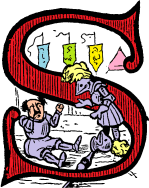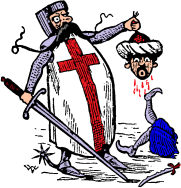HOME
Preface
Introduction
1
2
3
4
5
6
7
8
9
10
11
12
13
14
15
16
17
18
19
20
21
22
23
I
YE COMIC HISTORY OF HERALDRY.
CHAPTER I.
HOW HERALDRY AROSE.
OME writers on Heraldry, who have plied the pickaxe of research in the mouldy caverns of antiquity, digging so deeply that they have gone completely through the (w)hole and come out on the other side, place the origin of the science as far back as the flood. They assert that Noah was the first possessor of a coat of arms. But in these materialistic days, when the eye of the sceptic is apt to be drawn down with the wink of incredulity, we must decline to accept so very far-fetched a statement without some stronger proof than bare assertions, which in this case can scarcely be regarded as the naked truth. Nevertheless, if we may believe the words of Homer, the poet of the siege of Troy--a city, which like medicine, was considerably shaken before it was taken, the heroes engaged in that siege had various devices painted upon their shields. From this we may infer that the armour of the combatants like the poet's account of the siege, was very highly coloured; moreover, the trick of the Wooden
Horse shows us that the Greeks, even in that early age, were decidedly clever in devices.
Æschylus in his celebrated sensational play of "Septem contra Thebas," which sounds in its translation of "Seven against Thebes," like part of a bet, describes the armour of the combatants, and from his description it is evident that mounting a piece, even in those primitive times, must have cost the spirited manager a drachma or two. Tydeus according to his account bore on his shield a full moon surrounded by stars. Tydeus was a gentleman of sanguinary, not to say cannibalistic propensities; for, after he was mortally wounded himself, having succeeded in killing his slayer, as a final consolation to his dying hours he had the body of his enemy brought to him, and commenced to make a nasty, but perhaps to him satisfactory, meal of its brains. Minerva, the Goddess of Wisdom, who was coming to restore him, displeased at this bad taste and want of manners, allowed him to die, as a gentle hint to future warriors not to indulge in irregular meals.
Eteocles, according to the same author, bore "an armed man ascending a ladder against a tower." As both he and his brother Polynices ultimately settled their little personal differences in a manner fatal to both of them, the ladder must evidently have been typical of the rounds they were going to have. Polynices, by the way, had on his shield "Justice leading an armed man." What this device referred to is difficult to say, and the probability is, Polynices himself did not know, but thought perhaps it would look neat in a family fight, and that the figure of Justice might in some vague way be connected with his claim to the throne of Thebes.
The shields of other champions are also described at some length by Æschylus, but after all enough is as good as a feast, and we will pass on at once to a very big hero indeed.
Open your eyes, blow your noses, don't breathe on the Heraldic glasses, and make way for a conqueror ; for here comes Alexander the Great, a warrior who fell an early victim to his strict adherence to anti-temperance principles--and a natural hatred to the Sir Wilfrid Lawsons of the period. He granted to his favourite captains various badges to be worn on their armour, as rewards for valour. These badges were strictly copyright, and any one who was guilty, to use the words of a Mosaic celebrity, of "the untradesmanlike falsehood" of imitating them, or even stating that "it was the same concern" was very liable to be waited on by the party aggrieved and to make the discovery that it is not only leather that gets tanned.
To descend, however, from the mountains of tradition to the level plains of historical truth ; the earliest proficients in Heraldry were the French and Normans, and by the latter it was introduced into England amongst other civilizing influences, such as feudalism, cookery, and confiscation of Saxon goods and chattels, &c. We find, also, that Philip the Falconer, Emperor of Germany, A.D. 920, who, if the same person as the one referred to in a song once popular, was always "up with the day," giving an idea that he was continually engaged in running a race with Time, planted the first seeds of the Heraldic tree by the establishment of a law regulating tournaments.
At these knightly games, which were practised daily, each of the warriors was cased in iron from head to foot, a very stiff binding, and one not unfrequently illustrated with cuts. Not even their faces were visible, or as an old writer on the subject aptly describes it, "Behinde y-e ironne pottes (meaning their helmets) onne colde notte "see y-e mugges."
Such being the case, or would It be wrong to say, casing, without some method of distinguishing a friend from a foe, the most awkward mistakes must have arisen. For example, fancy the feelings of a young and stalwart knight, having struck down, as he imagined, the hereditary foeman of his race, upon discovering that he had bestowed what the Irish term "a topper for luck" upon a rich and choleric relation of whose domains he looked for a prospective share.
It was, therefore, to avoid such dreadful trials to human fortitude, that Philip the Falconer ordered that in battle, every knight should wear some peculiar cognizance, whereby he might be known, and if his credit were good, trusted.
In the Crusades, the warriors adopted, in many instances, a cross, and their actions but too frequently corresponded with their cognizances, being very often upon the cross and not at all upon the square; escallops, which had nothing to do with scalloped oysters, but were shells much affected by pilgrims--a class of gentry averse to shelling out in a general way--and martlets, small heraldic birds which differ considerably from natural feathered bipeds, and were usually worn by younger sons ; besides numerous other badges denoting that the knight went forth to fight the Paynim, urged thereto by mixed feelings of piety and plunder, the latter predominating.
Hallam, whose "History of the Constitution" proves his own must have been a remarkably tough one to have mastered so dry a subject, places the first regular blazoning of arms in the twelfth century, but it was not until the Third Crusade (A.D. 1189) that the fleur-de-lys first sprouted on the French coat of arms, and the Lions jumped upon the English shield.
Hereditary coats of arms are not found before the beginning of the thirteenth century, indeed some writers place them at the beginning of the sixteenth, the probability being that the custom was gradually obtaining but was not definitively settled until the latter date. Any how it is a proof that up to that time every man stood on his own footing, and that although he might step into his father's shoes yet he had to find his own coat.
Heraldry thus arose by slow degrees until a coat of arms became one of those articles without which no mediaeval gentleman's wardrobe could be said to be complete.
I
1
2
3
4
5
6
7
8
9
10
11
12
13
14
15
16
17
18
19
20
21
22
23
Preface
Introduction
HOME
Build: 2019/04/20 14:20:08.59+0900(JST)



